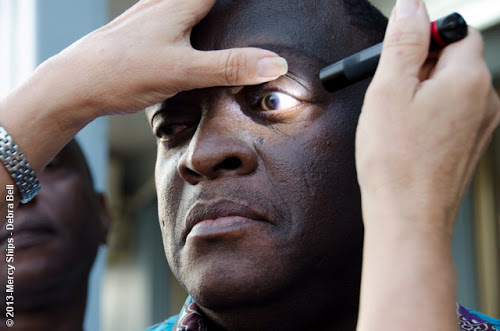Eye Center Andalusia: State-of-the-Art Care for All Ages
Eye Center Andalusia: State-of-the-Art Care for All Ages
Blog Article
Understanding the Various Vision Correction Procedures Available for Clearer View
In the realm of vision correction treatments, a wide range of alternatives exist to attend to refractive errors and provide people with clearer view. From the extensively identified LASIK surgical treatment to less intrusive procedures like PRK and implantable lenses, the area of ophthalmology provides a variety of strategies tailored to match different requirements and preferences. Each treatment includes its very own set of factors to consider, benefits, and potential dangers. Understanding the subtleties of these vision adjustment approaches is important for making informed choices about one's visual wellness. Let's discover the intricacies of these treatments and shed light on the course to attaining improved vision quality.
LASIK Surgical Procedure
LASIK surgical procedure is an usual refractive treatment made use of to deal with vision troubles such as astigmatism, nearsightedness, and farsightedness. This medical technique, which stands for Laser-Assisted in Situ Keratomileusis, aims to improve the cornea to improve how light is focused on the retina, ultimately boosting vision quality.
Among the primary advantages of LASIK surgical procedure is the fast enhancement in vision experienced by clients. Many people discover a considerable enhancement in their sight immediately after the treatment. Furthermore, the majority of people report minimal discomfort and discomfort throughout the surgery and recovery duration. The recovery time for LASIK is reasonably quick, with many people returning to their daily tasks within a day or two post-operation. Overall, LASIK surgery is a preferred option for individuals looking for a long-term remedy for their vision troubles.
PRK Treatment

PRK is an ideal option for individuals with thin corneas or those at a greater danger of eye injuries, as it does not entail developing a corneal flap. The healing process for PRK is a little longer compared to LASIK, as the epithelium needs time to regenerate. People may experience discomfort and blurry vision for a few days complying with the procedure.
In spite of the longer recuperation time, PRK can yield outstanding lead to vision improvement, making it a useful option for those who may not appropriate prospects for LASIK surgical procedure. - Cardiologist Andalusia
Implantable Lenses
As opposed to PRK where the cornea is improved straight, implantable lenses use an additional approach for dealing with vision by putting fabricated lenses inside the eye. This procedure is specifically beneficial for people with high levels of nearsightedness, farsightedness, or astigmatism that might not appropriate candidates for laser surgeries like LASIK or PRK.
Implantable lenses, also called phakic intraocular lenses, work by supplementing the eye's natural lens with a fabricated one. These lenses can be positioned in front of the natural lens (anterior chamber) or behind the iris and in front of the natural lens (posterior chamber) By readjusting the power and positioning of these lenses, eye doctors can efficiently correct refractive mistakes and improve visual acuity.
One benefit of implantable lenses is that they are removable and exchangeable, offering flexibility for future changes. As with any kind of surgical treatment, there are dangers included, such as infection or cataract formation. Patients taking into consideration implantable lenses must speak with an eye treatment professional to establish the most appropriate choice based upon their private demands and eye health.
Corneal Rings

The treatment for putting corneal rings is minimally intrusive and reasonably fast, often carried out as an outpatient procedure. During the surgery, the ophthalmologist makes a little cut in the cornea and inserts the rings at a certain depth. When in position, the rings aid to reshape the cornea, supplying a smoother surface area for light to enter the eye, which can result in clearer vision.
Corneal rings are considered a reversible procedure, as they can be removed or changed if essential. While they may not entirely remove the demand for glasses or get in touch with lenses, corneal rings can dramatically boost vision high quality and general visual comfort Look At This for people with keratoconus or other corneal irregularities.
Refractive Lens Exchange
Following the correction of corneal abnormalities with treatments like corneal rings, one more vision adjustment strategy that can resolve refractive errors is Refractive Lens Exchange (RLE) RLE is an operation that entails changing the eye's natural lens with a synthetic intraocular lens (IOL) to fix refractive errors such as presbyopia, nearsightedness, and farsightedness. This procedure is specifically helpful for individuals who might not appropriate prospects for procedures like LASIK or PRK as a result of aspects such as thin corneas or high refractive errors.
Recovery time for RLE is relatively quick, and individuals can anticipate better vision soon after the procedure. As with any surgical procedure, potential threats and difficulties exist, so a detailed appointment with an eye care expert is crucial to determine if RLE is the appropriate vision adjustment option.
Final Thought

In the world of vision modification procedures, a plethora of alternatives exist to deal with refractive errors and supply individuals with more clear sight.LASIK surgical procedure is a typical refractive procedure made use of to fix vision problems such as nearsightedness, farsightedness, and astigmatism.While likewise a common refractive treatment, the PRK (Photorefractive Keratectomy) technique varies from LASIK surgery in its technique to correcting resource vision issues.Adhering to the modification of corneal irregularities with procedures like corneal rings, an additional vision correction method that can resolve refractive errors is Refractive Lens Exchange (RLE) LASIK surgery, PRK procedure, implantable lenses, corneal rings, and refractive lens exchange are all alternatives that can resolve different vision issues.
Report this page